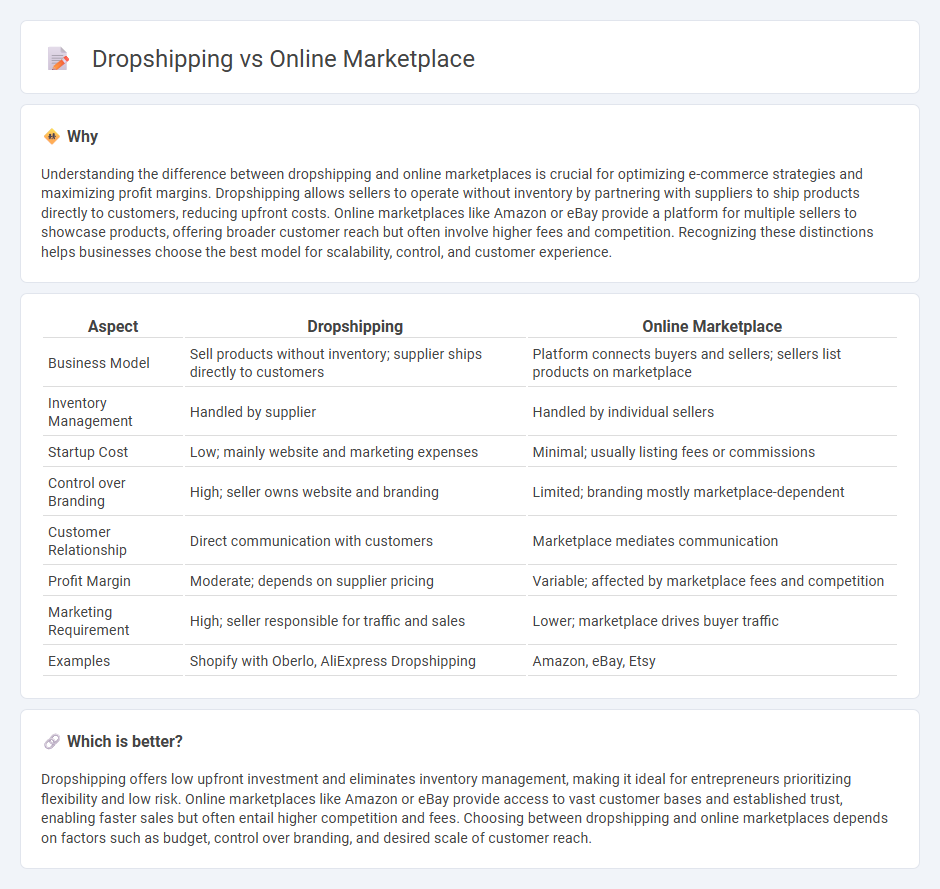
Dropshipping enables retailers to sell products without holding inventory, relying on suppliers to fulfill orders directly to customers, minimizing upfront costs and inventory risks. Online marketplaces aggregate multiple sellers and products on a single platform, offering extensive product variety and built-in customer trust but often involve fees and competition. Explore the key differences to identify which e-commerce model suits your business goals best.
Why it is important
Understanding the difference between dropshipping and online marketplaces is crucial for optimizing e-commerce strategies and maximizing profit margins. Dropshipping allows sellers to operate without inventory by partnering with suppliers to ship products directly to customers, reducing upfront costs. Online marketplaces like Amazon or eBay provide a platform for multiple sellers to showcase products, offering broader customer reach but often involve higher fees and competition. Recognizing these distinctions helps businesses choose the best model for scalability, control, and customer experience.
Comparison Table
| Aspect | Dropshipping | Online Marketplace |
|---|---|---|
| Business Model | Sell products without inventory; supplier ships directly to customers | Platform connects buyers and sellers; sellers list products on marketplace |
| Inventory Management | Handled by supplier | Handled by individual sellers |
| Startup Cost | Low; mainly website and marketing expenses | Minimal; usually listing fees or commissions |
| Control over Branding | High; seller owns website and branding | Limited; branding mostly marketplace-dependent |
| Customer Relationship | Direct communication with customers | Marketplace mediates communication |
| Profit Margin | Moderate; depends on supplier pricing | Variable; affected by marketplace fees and competition |
| Marketing Requirement | High; seller responsible for traffic and sales | Lower; marketplace drives buyer traffic |
| Examples | Shopify with Oberlo, AliExpress Dropshipping | Amazon, eBay, Etsy |
Which is better?
Dropshipping offers low upfront investment and eliminates inventory management, making it ideal for entrepreneurs prioritizing flexibility and low risk. Online marketplaces like Amazon or eBay provide access to vast customer bases and established trust, enabling faster sales but often entail higher competition and fees. Choosing between dropshipping and online marketplaces depends on factors such as budget, control over branding, and desired scale of customer reach.
Connection
Dropshipping and online marketplaces are interconnected through their reliance on digital platforms for product distribution, where dropshipping enables sellers to list items without holding inventory, while marketplaces provide the audience and infrastructure for transaction facilitation. This synergy reduces upfront costs and inventory risks for entrepreneurs, leveraging marketplace traffic to boost sales efficiency. Effective integration of dropshipping with marketplaces like Amazon or eBay expands product variety and scaling opportunities, enhancing e-commerce competitiveness.
Key Terms
Platform Fees
Online marketplaces like Amazon and eBay often charge listing fees, final value fees, and monthly subscription costs that vary based on product categories and sales volume. Dropshipping platforms typically involve lower upfront costs but may include monthly membership fees, transaction fees, or charges from suppliers for order fulfillment services. Explore detailed fee structures to determine which model offers the best cost efficiency for your business goals.
Inventory Management
Online marketplaces often centralize inventory management by integrating with multiple suppliers, enabling real-time stock updates and streamlined order fulfillment. Dropshipping relies on third-party suppliers to manage inventory, reducing upfront investment but increasing dependency on supplier accuracy and shipping times. Explore the advantages and challenges of each model to optimize your inventory strategy effectively.
Order Fulfillment
Order fulfillment in online marketplaces involves managing inventory, processing payments, and shipping products directly to customers, often providing sellers with integrated logistics support. Dropshipping eliminates the need for sellers to hold inventory or handle shipping, as suppliers manage product storage and delivery, reducing upfront costs but potentially lengthening delivery times. Explore how each model impacts efficiency and customer satisfaction to determine the best approach for your e-commerce strategy.
Source and External Links
What Is an Online Marketplace? - AppDirect - An online marketplace is a website or app where customers can buy products or services from multiple brands or a single provider, streamlining the shopping experience by enabling transactions and product comparisons in one place.
The best online marketplaces for ecommerce sellers (2025) - Top online marketplaces like Amazon, Walmart, and eBay give sellers access to large built-in customer bases, trusted infrastructure, and international reach, making them powerful platforms for ecommerce growth.
22 Selling Websites and Marketplaces for Selling Things Online ... - There are numerous online marketplaces and selling sites--including Amazon, eBay, Etsy, and niche platforms--each offering unique benefits, but selling fees and platform rules are important factors to consider alongside marketplace exposure.
 dowidth.com
dowidth.com